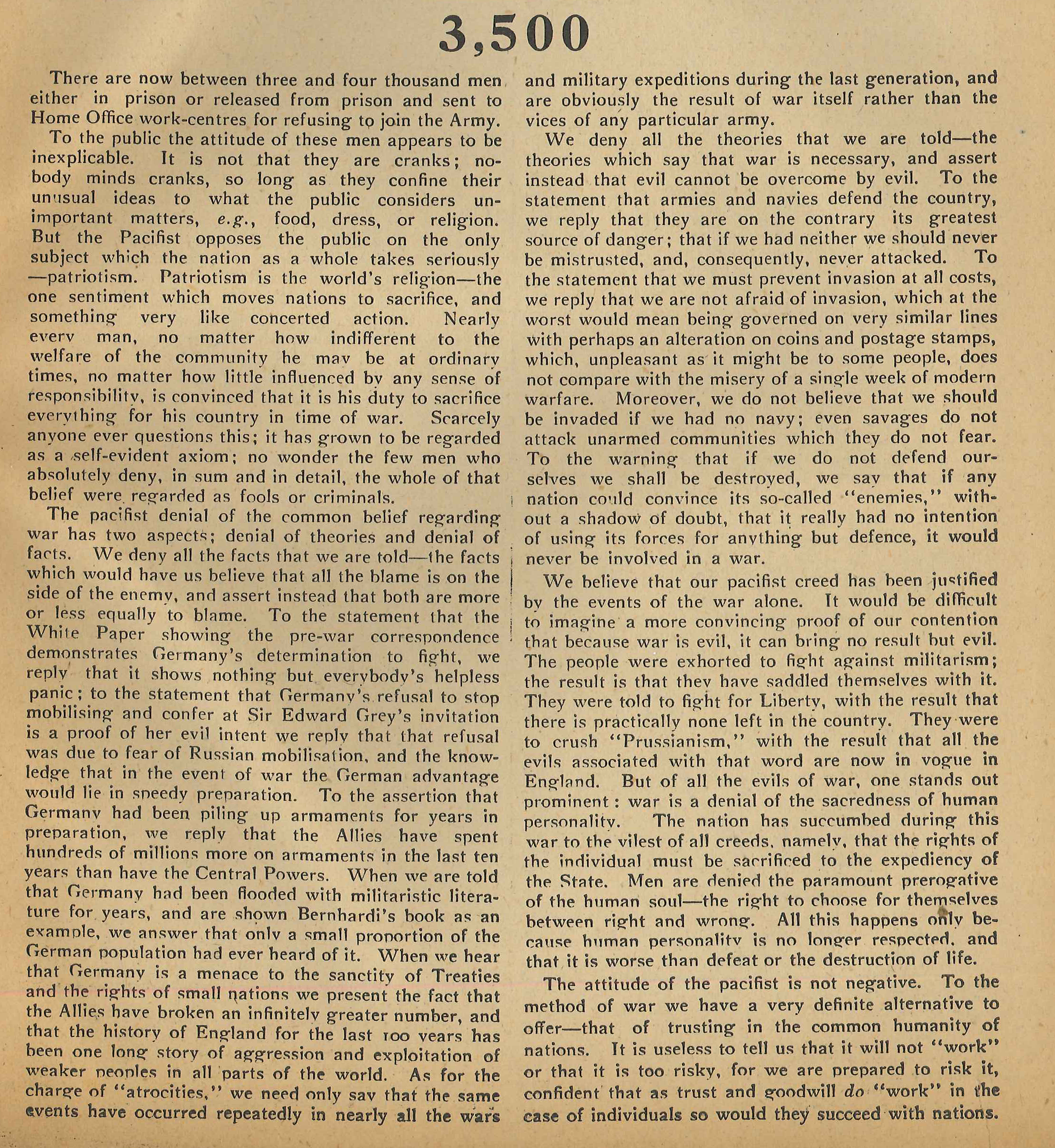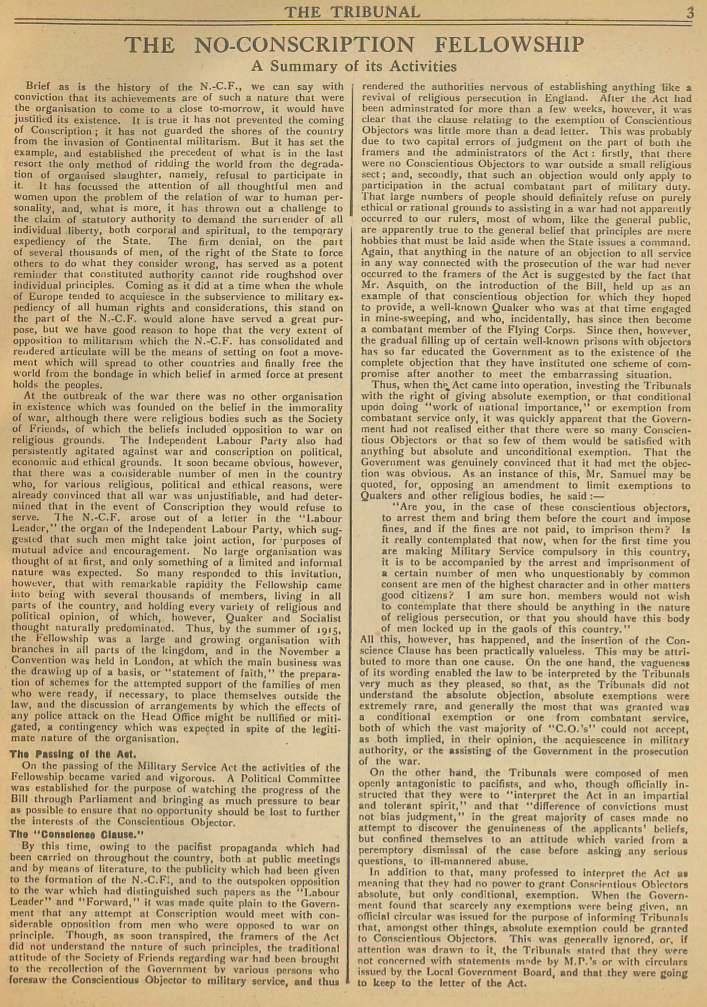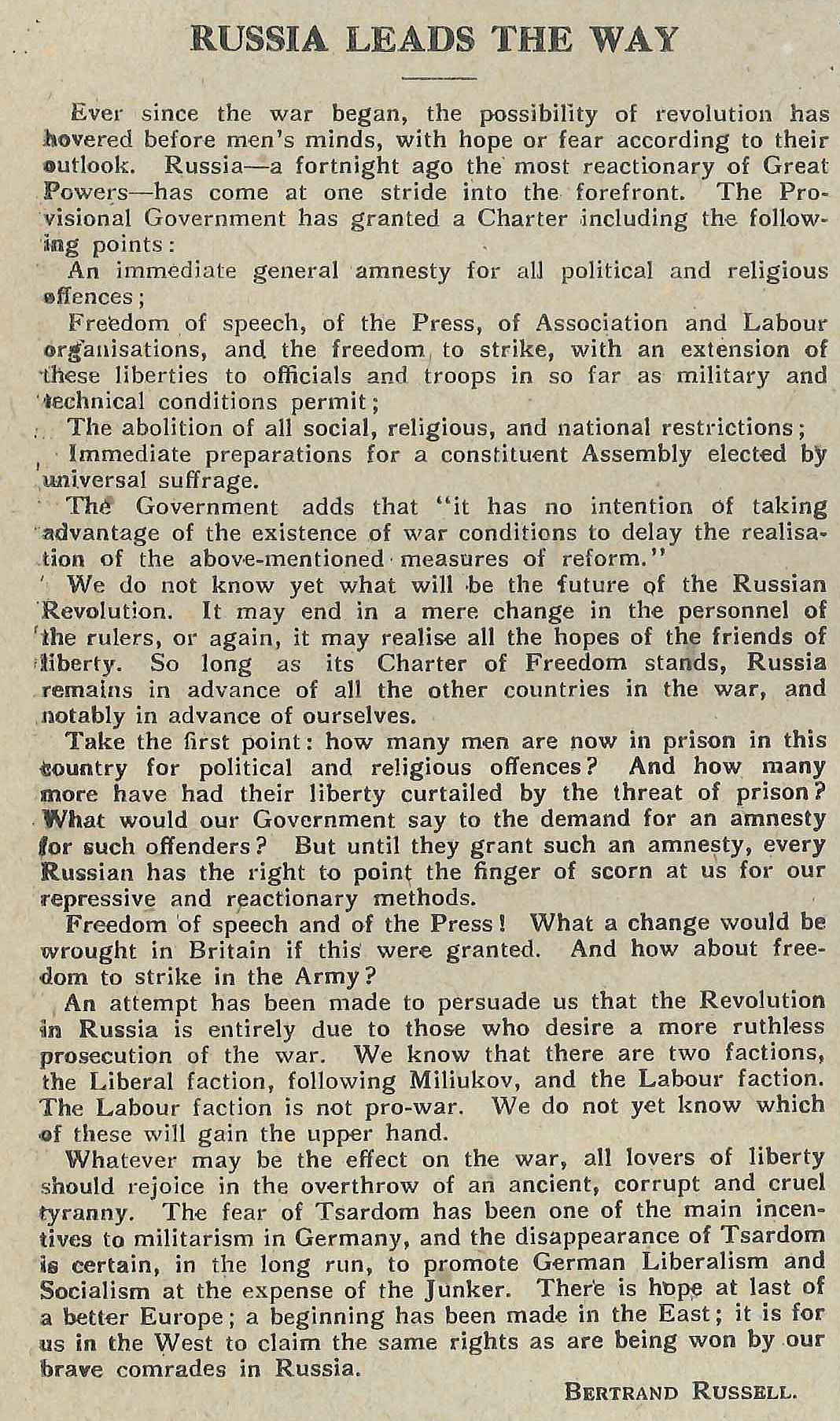
| HOME | TRIBUNAL HOME |
March 1917
March 1917 was the anniversary of both the Military Service Act 1916 and the publication of The Tribunal. One year after Conscription had been introduced and the No-Conscription Fellowship had switched it’s focus from campaigning against it’s introduction to supporting those men caught up in the arbitrary and cruel system, little had changed. Conscientious Objectors were being imprisoned in ever increasing numbers, Conscription was by now firmly anchored by the increasingly hysterical rhetoric spouted by the popular press and the end of the war appeared nowhere in sight. Given the context of the time, March 1917 might have been a rather depressing month in the pages of The Tribunal. Instead it saw a plethora of articles confirming and even celebrating the work of the NCF and the resistance of Conscientious Objectors - acknowledging the victories and defeats of the previous year, but looking forward to hard work ahead.
8th March 1917
The 8th of March issue of The Tribunal formed it’s retrospective look at the activities of the No-Conscription Fellowship in the preceding year. Two articles stand out as excellent summaries of the position COs found themselves in, one year after the first arrests under the Military Service Act.
“3,500”
The headline article for the 8th of March provides one of the first significant and well-supported tallies of the total number of Absolutist Conscientious Objectors in prison in Britain. The NCF and by extension The Tribunal had been collecting and monitoring information on Absolutist COs since the first days of Conscription, and this number - three thousand five hundred Conscientious Objectors in prison - was the results of this collection. It was a very important figure to highlight. The government, in order to smooth the passage of Conscription in parliament had assured MPs that the number of Absolutist COs would be extremely small. With 3,500 in prison - that the NCF was aware of - only 12 months after the introduction of Conscription, it was clear that the Absolutist position was far more widespread and more popular than had been previously thought.
The NCF and by extension The Tribunal had been collecting and monitoring information on Absolutist COs since the first days of Conscription, and this number - three thousand five hundred Conscientious Objectors in prison - was the results of this collection. It was a very important figure to highlight. The government, in order to smooth the passage of Conscription in parliament had assured MPs that the number of Absolutist COs would be extremely small. With 3,500 in prison - that the NCF was aware of - only 12 months after the introduction of Conscription, it was clear that the Absolutist position was far more widespread and more popular than had been previously thought.
Holding up both the number and the character of the Absolutist position functioned as powerful propaganda, and the article forms a clear statement of the beliefs of Absolutist COs - that “Evil cannot be overcome by Evil”. The article makes the Government position obvious, and highlights the essential fact of the matter - that Absolutists were political prisoners held against their will due to their opinions and morality, just as under any tyrannical autocratic system Britain was supposedly fighting against.
The clarity and uncompromising nature of the Absolutist CO as depicted in the article still poses questions for us today, particularly when considering the nature of the First World War. The article states: “Our pacifist creed has been justified by the events of the war alone. It would be difficult to imagine a more convincing proof of our contention”. In many ways this statement has only become more obvious and more relevant with the passing of time. The First World War was and is still seen as one of the ultimate testaments to pacifist principles - an avoidable, unimaginably horrific and foolish war that is now widely condemned as a deliberate and bloody slaughter.
The Actions of the NCF
A four page spread on the history and activities of the NCF made the 8th March issue much larger than any preceding it. The review article gives a rather comprehensive retrospective on  Conscientious Objection, Objectors and the associated issues covered by The Tribunal from 1916-1917 (much as these articles hope to do!). The past and present of the movement is clearly laid out.
Conscientious Objection, Objectors and the associated issues covered by The Tribunal from 1916-1917 (much as these articles hope to do!). The past and present of the movement is clearly laid out.
The future of the movement was not so clear. The Tribunal did not conclude it’s retrospective with the happy hope of an imminent peaceful settlement and an end to war, but with warnings that militarism would only increase as the war went on and that conscription was likely to be extended time and time again. Imprisonment, brutality and death were likely to continue as the by now almost traditional punishments of the CO. However, there is some hope. The Tribunal sees no end to the work of the NCF, a task it sees stretching beyond the end of the war until they can “save the children of the present soldier from the horrors he himself is undergoing”.
March 22nd 1917
“Russia Leads the Way”
The Tribunal could certainly receive and publish news quickly, and this article on the February Revolution and it’s after effects in Russia was published only a week after the abdication of the Tsar. It celebrates the achievements of the Provisional Government in taking strides towards a better - and in the eyes of The Tribunal, more pacifist - society. Many of the decisions of the Provisional Government clearly thrilled the NCF, as it promised a free press and free speech at a time when The Tribunal was under constant threats of police raids and censorship, and the release of all political prisoners when 3,500 COs were imprisoned in Britain. Articles such as this one became a common thread of socialist thought for much of the 20th century and the prospect of a Russia free from the Autocracy of the Tsar acting as a beacon of peace in the tumult of the First World War is one that many anti-war activists clung to.
Revolution and it’s after effects in Russia was published only a week after the abdication of the Tsar. It celebrates the achievements of the Provisional Government in taking strides towards a better - and in the eyes of The Tribunal, more pacifist - society. Many of the decisions of the Provisional Government clearly thrilled the NCF, as it promised a free press and free speech at a time when The Tribunal was under constant threats of police raids and censorship, and the release of all political prisoners when 3,500 COs were imprisoned in Britain. Articles such as this one became a common thread of socialist thought for much of the 20th century and the prospect of a Russia free from the Autocracy of the Tsar acting as a beacon of peace in the tumult of the First World War is one that many anti-war activists clung to.
From our vantage point of 2015, it’s hard to see the hope expressed in both the retrospective and Russian articles as anything other than unbearably tragic. At the time, however, there was a very real hope that the worst was over. COs continued to face brutality and imprisonment, but the members and staff of the NCF, including those writing the Tribunal, saw in these articles a very real hope for a solid and lasting peace.